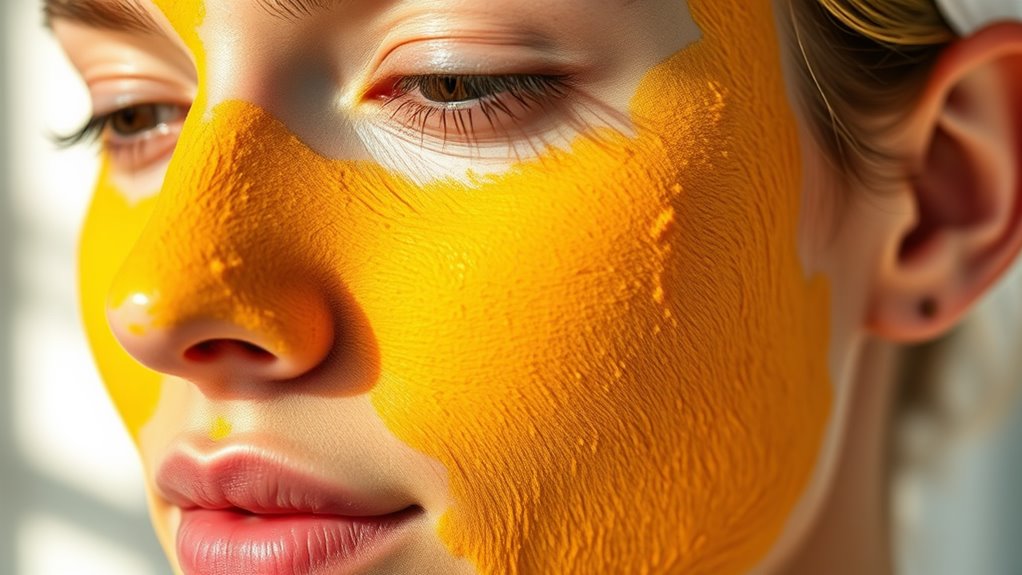This DIY Turmeric Mask Fades Dark Spots Fast
Just like a shield guarding against invaders, turmeric’s curcumin has shown anti-inflammatory effects in studies to combat dark spots. You can whip up this simple mask at home, but always patch test first. Stick around to learn the easy steps and tips for safer use.
Key Takeaways
- Turmeric’s curcumin reduces dark spots by inhibiting melanin production and offering anti-inflammatory benefits.
- Combine turmeric powder, raw honey, and plain yogurt to create an effective DIY mask for fading hyperpigmentation.
- Mix ingredients into a smooth paste in a bowl, adjusting consistency with yogurt as needed.
- Apply a thin layer to clean skin, focusing on dark spots, and leave on for 10-15 minutes before rinsing.
- Use twice weekly after a patch test, and follow with SPF 30 sunscreen for optimal, fast results.
Benefits of Turmeric for Skin
You’ve likely heard about turmeric’s skin benefits, and they’re worth exploring.
Turmeric for dark spots offers potential advantages, as its curcumin compound exhibits anti-inflammatory and antioxidant properties.
Studies indicate that it may inhibit melanin production, helping you fade hyperpigmentation from sun damage or acne scars.
While evidence from clinical trials supports these effects, results aren’t guaranteed for everyone, so approach with caution.
You should integrate turmeric cautiously into your routine, as overuse might irritate skin.
Always rely on peer-reviewed research and consult professionals for personalized advice.
For practical application, consider exploring DIY face masks that feature turmeric as a primary ingredient for targeted skin care.
Ingredients Needed for the Mask
To create your DIY turmeric mask, gather a few essential ingredients that support its skin-soothing effects. You’ll need turmeric powder as the star; research indicates its curcumin offers anti-inflammatory and antioxidant properties that may help fade dark spots. Add raw honey for its humectant qualities, which can hydrate skin and provide antibacterial support. Include plain yogurt, rich in lactic acid, to gently exfoliate and potentially brighten complexion. Always choose fresh, high-quality items and perform a patch test first to minimize irritation risks. This DIY approach aligns with the principles of homemade face masks, emphasizing natural materials for health benefits.
Steps to Prepare the Mask
Preparing your turmeric mask takes just a few straightforward steps to blend the ingredients effectively. First, you’ll place the turmeric powder into a clean bowl, then add honey and yogurt in measured amounts.
Stir vigorously with a spoon to create a smooth, lump-free paste, ensuring even distribution of turmeric’s potential antioxidants.
It’s wise to adjust the consistency by adding a bit more yogurt if needed, as this may help with application readiness without over-thinning. This mask preparation draws from scientific backing in dermatologist-vetted DIY skincare routines.
How to Apply the Mask
With your mask blended into a smooth paste, spread a thin layer across clean, dry skin using clean fingertips or a brush.
Apply it evenly, focusing on dark spots while avoiding sensitive areas like the eyes or broken skin to reduce irritation risks—evidence shows turmeric can be sensitizing for some.
Use gentle, circular motions for better coverage, ensuring the paste doesn’t drip.
Always wash your hands first to prevent contamination, as poor hygiene may introduce bacteria.
To achieve optimal results, leave the mask on for 10-15 minutes before rinsing gently with lukewarm water.
Tips for Optimal Results
While applying your turmeric mask, focus on key strategies to boost its effectiveness and minimize risks.
First, perform a patch test to detect potential allergies, as turmeric can irritate sensitive skin.
Apply a thin, even layer and massage gently for better absorption, based on its anti-inflammatory properties.
Leave it on for 15-20 minutes only, avoiding overuse to prevent dryness.
Use it twice weekly for consistent results, and combine with honey for added hydration.
Always follow with sunscreen, since UV rays can worsen dark spots, and consult a dermatologist if irritation occurs.
For best results, choose a sunscreen with at least SPF 30 and reapply every two hours when outdoors.

